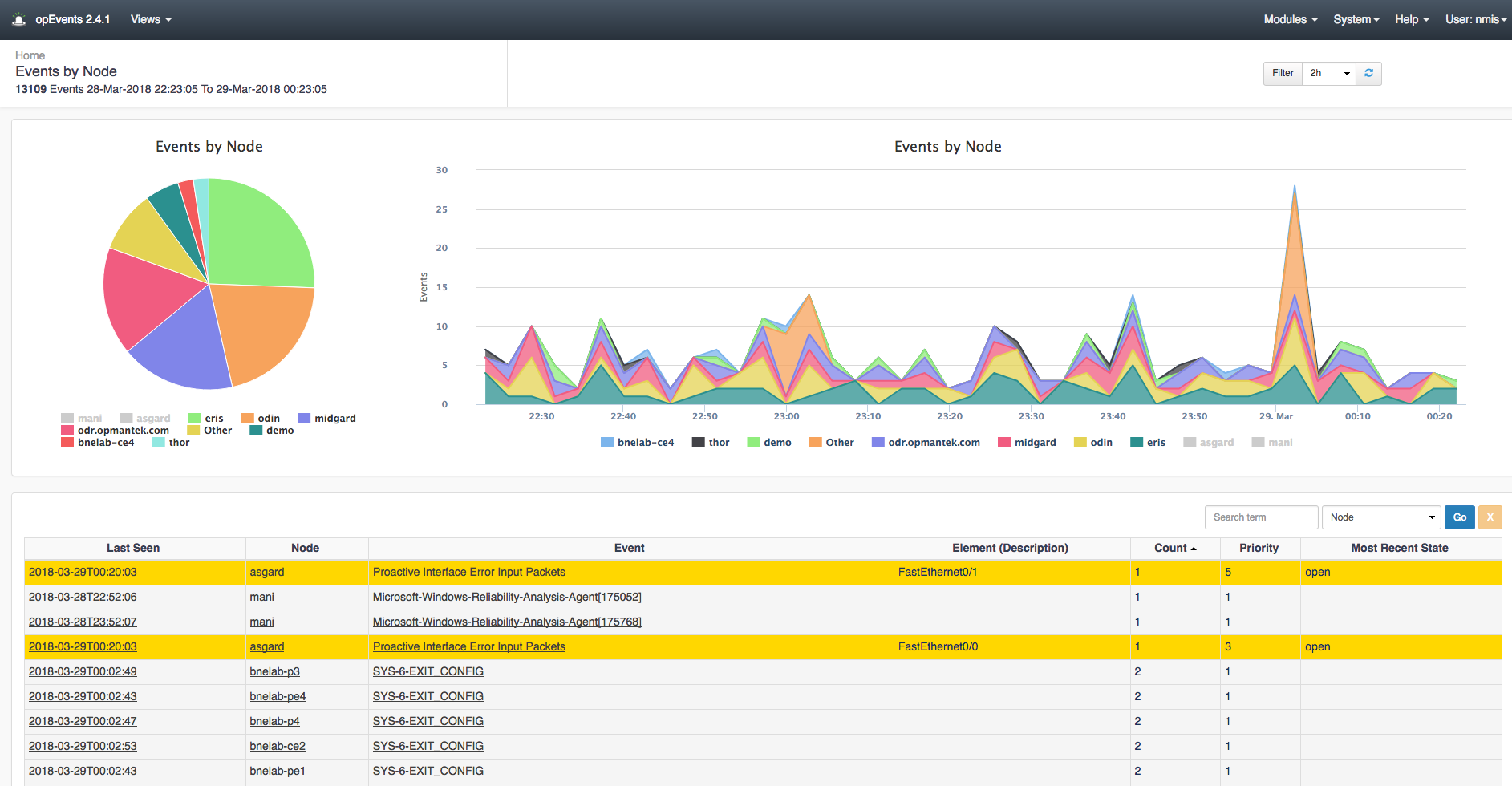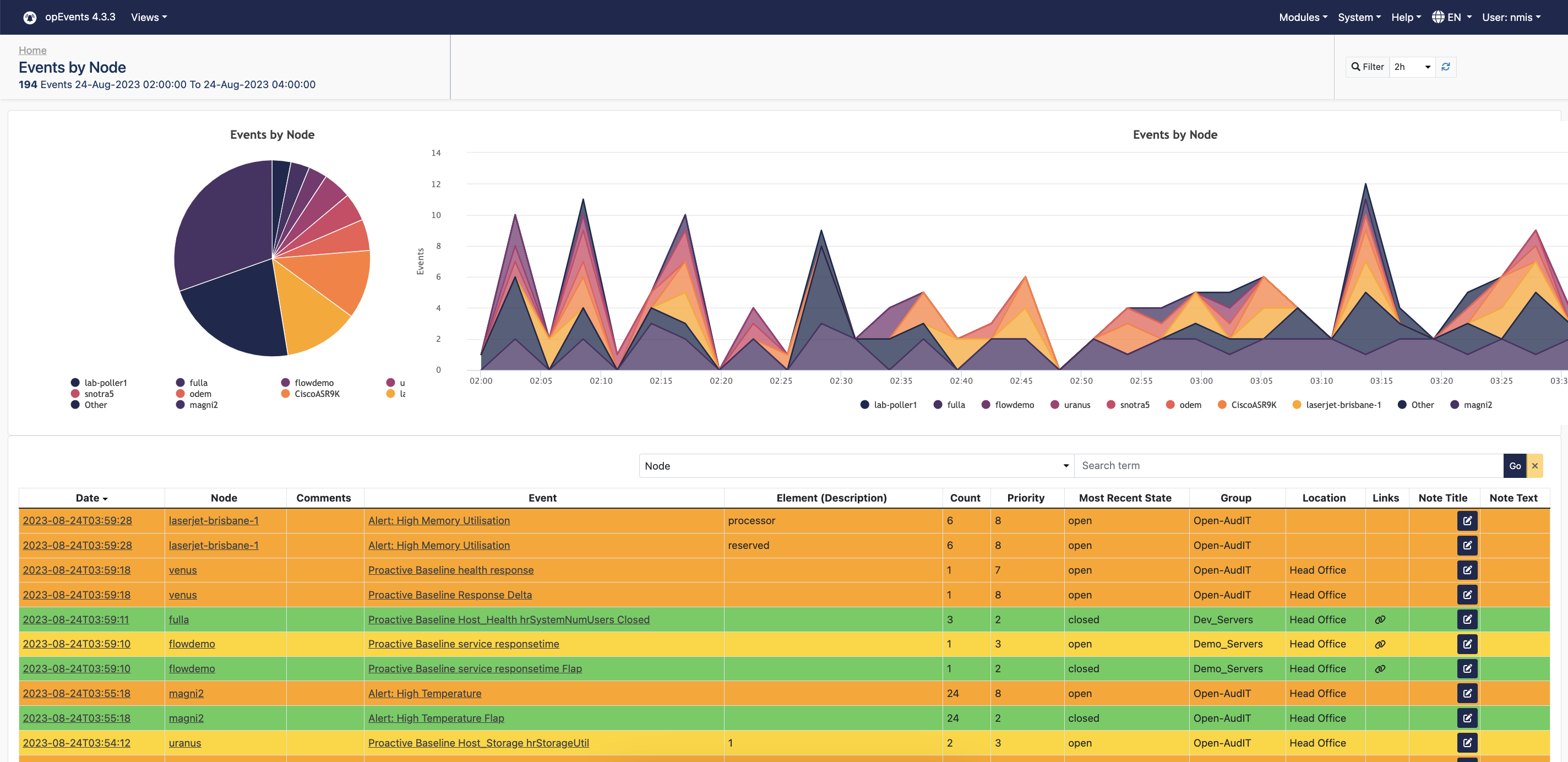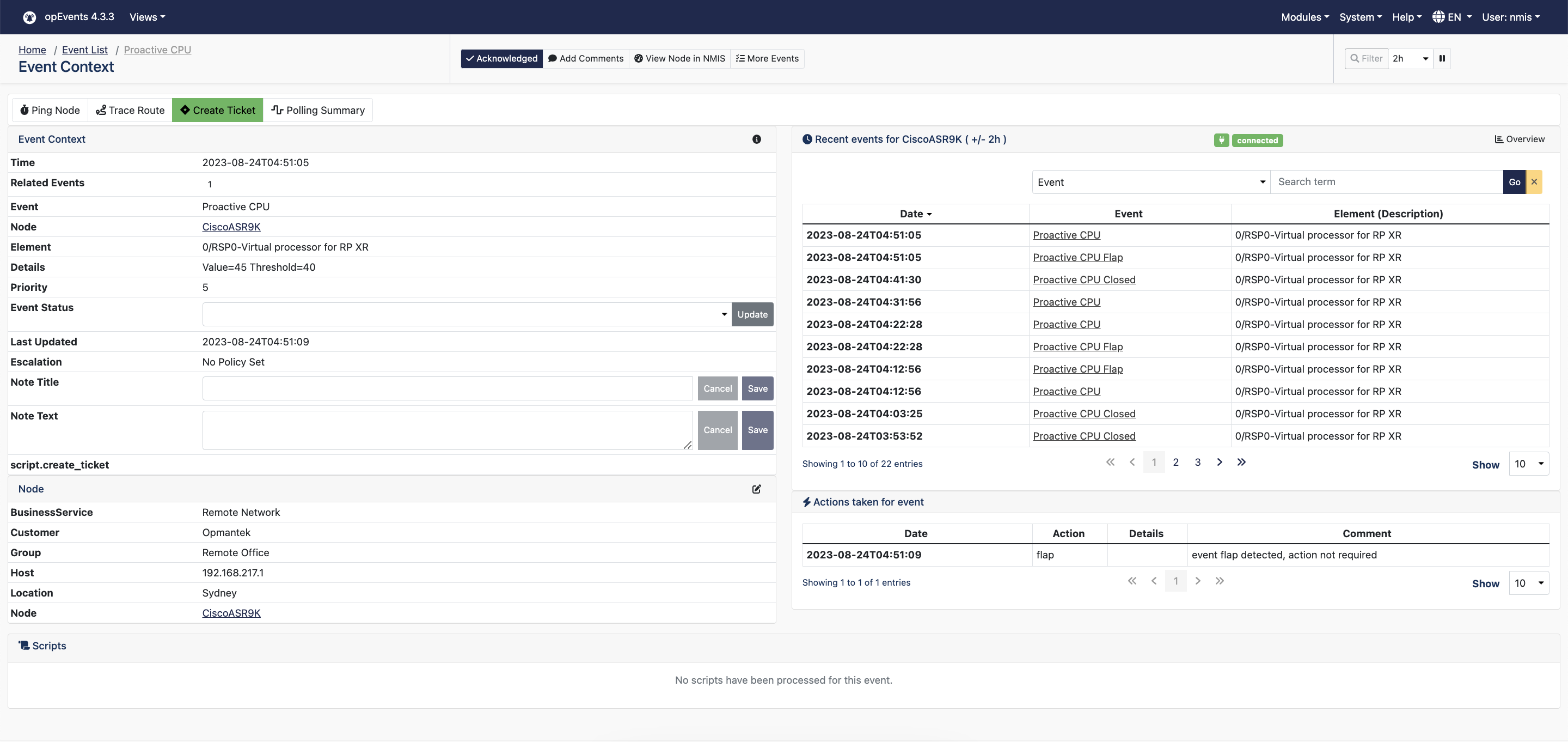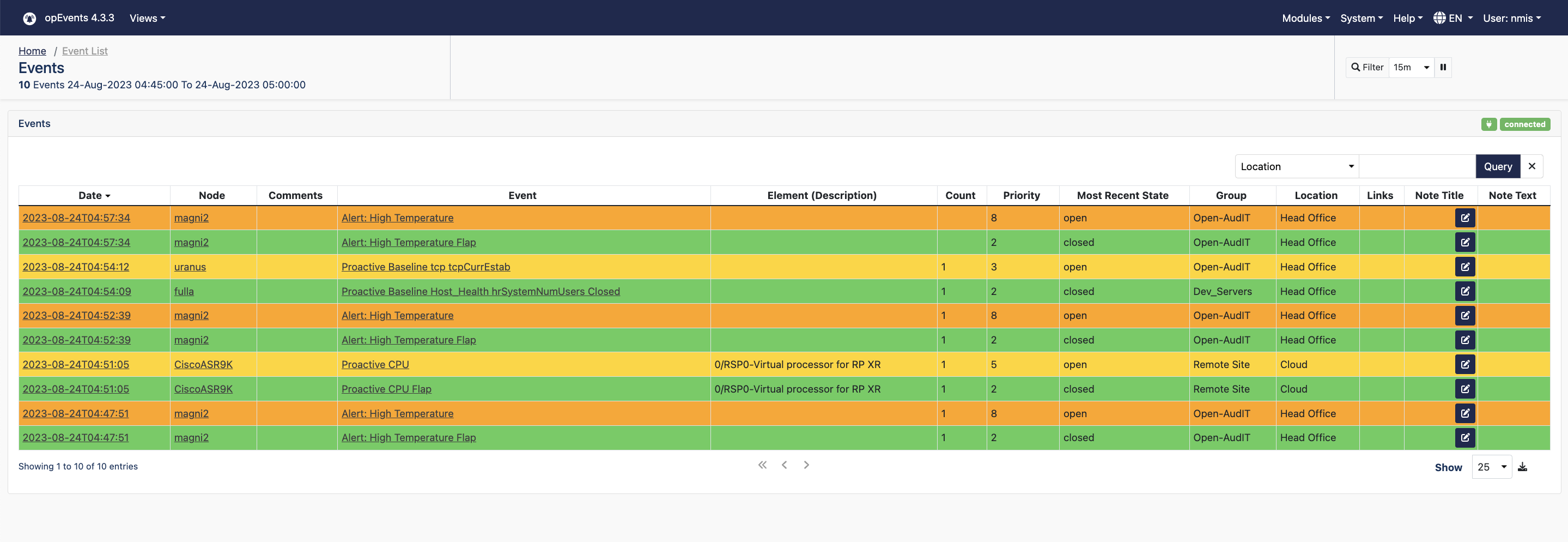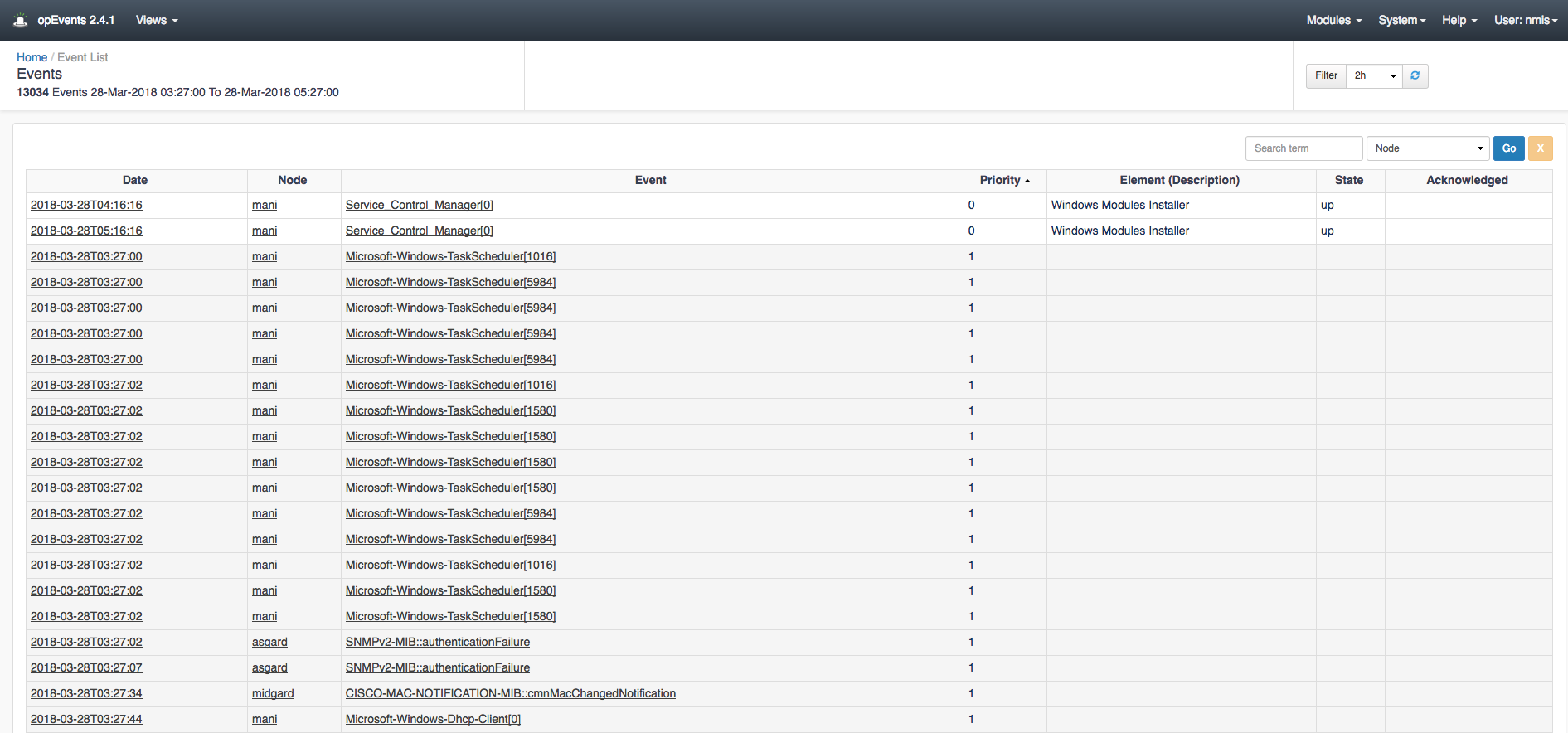| Table of Contents |
|---|
opEvents Views
This is an introduction to all the Views in opEvents.
Dashboard View
The default view in opEvents shows the Dashboard which Dashboard View gives you a snapshot of the nodes with the most events in your environment in simple, easy-to-grasp graphical and tabular formats. It displays the Events by Node . From this page you can visually see which devices are generating the most events. Clicking on the pie chart or the graph to the right of charts, filtered according to the specified Time Filter and the most recent events in a table. The Dashboard View is the default Home page for opEvents.
- Use the time Filter function located at the top right corner of the chart to specify the particular time period you want to look for the events in.
- Hover over a segment of the pie chart to see the device name.
- Click on a segment for a comprehensive look at the events on the specific device, occurred during the indicated time period.
- If you don't want to display a specific device on the chart/graph, you can filter it out by clicking on its name in the legend below the chart/graph.
In the table below the charts, you can see the list of the most recent events, with the it allows you to drill into the events of a specific device or the list of events that occurred in specific time periods. Clicking on the device name at the bottom of the Events by Node charts allows you to filter out devices you do not want to display on the charts granting you the ability to customize your charts view. In the table below the two charts you can see the time of the event, the node, the event name, description of the event, the amount number of times this the event occurred, the priority, and the most recent state of the node. These can be sorted by event count, priority, event name, or which ever makes finding relevant events easier. The table also has a search field located above the count column making finding specific events quickly. With the time filter located in the top right of the chart you can filter the time period to view events generated during certain time windows.
On any of these pages in the menu -> Views drop down menu you can click on the event Name, Node, Last Seen, Title, etc. and drill into more granular details. In the example below I am clicking the link to the device "asgard" which opens up the "Node Context" page. If you click on an event an "Event Context" page would open giving you more granular details about the specific event as well. As you can see there is much more useful and specific information provided from this page. Using the example below, there are six menu options at the top: Details, View Node in NMIS, Show Address Configuration, Show Node Performance, Show Node Configuration, and More. Clicking the "Details" menu item displays the complete raw details for the specific node or event. Clicking on "View Node in NMIS" opens up an NMIS Node Details menu. Clicking the "Show Address Configuration" will open up our opAddress module that gives information on the ip addresses for this device. "Show Node Performance" will open the device information screen in our opCharts module. Clicking on "Show Node Configurations" will open our opConfig module displaying recent commands and configuration changes, etc. for the device. The "More" drop down menu gives you the ability to edit the node or view more events if you happen to be viewing an Event Context page.
...
- Click on a column name/heading to sort the events list by ascending or descending order and find the required events more easily.
- Use the Search field above the table to find a specific event quickly. You can also narrow the search by selecting a column name from the drop-down list beside the Search field.
Time Filter
The top right-hand corner of the Event views page has a Filter widget with three buttons:
- Filter for Advanced Filters - Time Filters, Event Filter, and Summarisation
- Period for quick Time Period filtering, with a drop-down of time periods
- Toggle to Toggle Auto Refresh
Node Context
To view more comprehensive information about a device, click on a node link under the Node column (from any of the Views pages). This will open the Node Context page of the device.
On the Node Context page, you can view a snapshot of the device properties, elements up and down, status, and the most recent events on the device.
- Click the Details menu item to view the complete raw details for the node.
- Click View Node in NMIS to open the Node Details page in NMIS.
- Click the Edit Node menu item to update the Node settings, including the node Name, Host, Location, etc.
- You can enable or disable the node activation and licensing here as well as add Comments for the node.
- You can also Delete the node on the Edit Node page.
- Click Node Tools to access tools like Ping, Trace, nslookup, etc. You can also open the Edit Node Configuration page from here.
- Click the Event Up or Event Down icon to open the Event Context page for that event.
...
- You can toggle the State Up
...
- and Down, or
...
- delete the state using the Edit State
...
- icons.
- In the Recent Events table, click the required link in the Event column to open its Event Context page.
- Click the Overview icon to open the Node Events Overview page that displays all of the node events on a single page.
- Similar to the Dashboard page, on this page too you can filter the events by time period, select/deselect the events displayed on the charts, search for Events, and probe further into each Event by clicking the Event link in the table.
Event Context
To learn more about an event or view more granular details about it, click on an event link under the Event column (from any of the Views pages). This will open the Event Context page for the event.
On the Event Context page, you can view a summary of the Event, the node it was generated on, Element, Priority, and the applicable Escalation policy (if configured).
- Click the Acknowledge menu item to acknowledge the event.
- You can add a comment to the Event listing using the Add Comments button in the menu.
- Click the View Node in NMIS button to open the Node Details page in NMIS.
- To view all the events reported in the same time period, click the More Events menu item. This will open the Events View page.
- You can add a custom Note Title and Note Text to the event for future reference, easy classification or filtering from the Events page or the Dashboard page.
- Click the Edit Node icon in the Node section if you want to update the Node settings, including the node Name, Host, Location, etc.
- You can enable or disable the node activation and licensing on the Edit Node page, as well as add Comments for the node.
- You can also Delete the node on this page.
- Under the Recent Events list, you can search for an Event or an Element (Description).
- Click on a link in the Event column to open its Event Context page.
- Click the Overview button to open the Node Events Overview page that displays all the events generated on the specific node.
- You can view the configured policy actions taken on each event under the Actions Taken for Event table.
Events View
From the top menu, choose Views > Events for a
Events View
Navigating to menu Views -> Events you can see a bit more detailed view of the table on the Dashboards Dashboard page. Notice above
- Above the table in the top left
...
- , you can see the total number of events
...
- being reported and the time period of the report.
- Apart from other information about the event, its name and the device it occurred on, you can also view the Element Description, event Priority and its Most Recent State.
- Click a link under the Date, Node, or Event columns for a more detailed view of them.
- You can add a Note Title to an event by clicking the edit icon in its row and adding it in the text field. After adding the Note Title, click the update icon.
- Click on a column heading to sort the events list by ascending or descending order and find the required events more easily.
- Use the Query field above the table to find a specific event quickly. You can also narrow the search by selecting a column name from the drop-down list beside the Query field.
- To generate a copy of this page in CSV format and download it, use the Export to CSV icon below the table.
- Specify the number of events you want to display in the table using the Show drop-down menu.
Current Events View
On the Views > Current Events,
If desired, you can change the page to display more than 25 events at a time by scrolling to the bottom of the page and selecting the drop down Show menu item. To the left of the Show menu item is a button which allows for this page to be exported to CSV granting you and your team the ability to share a detailed report of the events across your devices.
Each Date, Node, and Event are clickable and open up a more detailed view of them.
Current Events View
In this view you can Acknowledge events that have recently occurred and may not have been looked at yet. It allows for quick event acknowledgement by the bulk acknowledge feature which is accomplished noticed or acted upon yet.
- Select the events you want to acknowledge (by clicking the
...
- check boxes in the first column) and click the Acknowledge button above the table.
- You can also acknowledge all
...
- the events on
...
- the page
...
- in one
...
- go, by clicking the Select All check box and then clicking the Acknowledge button.
- You can add a Note Title to an event by clicking the edit icon in
...
- its row and adding it in the text filed. After adding the Note Title, click the update icon.
- You can specify the number of events to display in the table using the Show drop-down menu.
- Click a link under the Date, Node, or Event columns for further information about the device/event.
Actions View
The Views > Actions page displays the actions taken on the events
Actions View
The actions view located at menu -> Views -> Actions displays the actions taken for any given event. Event actions are the conditions an event must conform to and what actions to take in case of a match. The event Date, Name, Node, Action, Details, and Comment section is displayed on the table. These items on the table can be customized to your liking by adding or taking away information displayed on this page. These changes can be made by navigating to
- In the Actions table, you can view the Event name, its Date, the Node on which the event has occurred, the Action taken, and the Comments added about the specific action.
- You can sort the entries in the table by clicking the required column headers.
- Click an Event link or a Node link (in their respective columns) for further details about them.
- Generate a copy of this page in CSV format and download it using the Export to CSV icon below the table.
- Specify the number of events to display in the table using the Show drop-down menu.
- You can customize the information displayed on this page, including the columns of the table, by editing the
opEvents_action-log.jsonfile at/usr/local/omk/conf/table_schemas
...
- (on the server filesystem). For more information on how to edit these values
...
- , see opEvents 2.4.x -
...
...
You can find more details about which Actions can be managed at Event Actions and Escalation.
For example, the image below shows the default menu bar for the Actions view in opEvents.
After editing the opEvents_action-log.json file the extra column was added to the end of the row labeled "New Custom Column". This process can be replicated to display custom information in as many columns as you would like on this page.
More detail on what Actions can be managed can be found here: Event Actions and Escalation
Raw Logs View
The On the Views > Raw Logs page, you can view displays the current raw event logs. This view is useful for viewing what the full event message says within the Entry column. Clicking the
- Click on an Event ID link
...
- to open
...
- the Event
...
- Context page and view the complete details about the event.
- Click on a log Date link to open the Raw Log Details page and view more details about the selected log.
- To generate a copy of this page in CSV format and download it, use the Export to CSV icon below the table.
- Specify the number of raw logs to display in the table using the Show drop-down menu.
- For a new Type of log to be displayed in the Raw Logs table, add an entry in the
opevents_logssection inopCommon.json, as well as inEventParserRules.json. You can find more information on this at opEvents input sources. - Use the time Filter function at the top right corner of the page to locate the required events more quickly.
- You can customize the information displayed on the Raw Logs page, including the columns of the table, by editing the
opEvents_raw-log.jsonfile at/usr/local/omk/conf/table_schemas
...
- . Learn more about editing these values at opEvents 2.4.x - Customising Table Columns.
Clicking on the link in the Date column will open up the Raw Log Details page providing you with more details of the selected log. An example of this page is provided below:
More For more information on opEvents and its logging system view this page here: , see opEvents - Centralized Logging Solution.
Archive Logs View
From the top menu bar, click Views > Archive Logs view lets you see the to view all types of archived logs along with their type of log and an Entry description. The
- Use the Filter function on the top right corner of the page
...
- to choose the number of days you want to look back for
...
- the logs depending on your log rotation setup.
...
- Generate a copy of this page in CSV format and download it using the Export to CSV
...
- icon below the table.
- Specify the number of logs to display in the table using the Show drop-down menu
...
- .
- Clicking the archive name under the Archive column will open
...
- the Archive
...
- Log Details page
...
- . It displays the event ID along with
...
- other details from the Archive Logs view pertaining to
...
- the event.
...
- To customize the columns in the Archive Logs table and other information displayed on this page
...
- , edit the
opEvents_archive-log.jsonfile at/usr/local/omk/conf/table_schemas
...
- . For more
...
- detail on how to edit these values
...
...
Nodes View
The Nodes View displays To view a list of all Nodes, the Nodes in your environment and a summary of their properties (including their Group, Location, Customer, Business Service(s)Services, and their Host. This view ), from the top menu bar, click Views > Nodes.
- The Nodes View allows you to quickly search for a specific node
...
- and view
...
- its events
...
- using the search box
...
- above the Nodes table.
- You can generate a copy of this page in CSV format
...
- by clicking the Export to CSV icon below the table.
- Specify the number of devices to display in the table using the Show drop-down menu.
...
- Click on a node Name to open the device's Node Context page, where you can view more detailed information about the device.
...
- You can customize the information displayed on this page
...
- , including the columns of the table, by editing the
opEvents_node-log.jsonfile at/usr/local/omk/conf/table_schemas
...
- (on the server filesystem). For more information on
...
- how to edit these
...
- settings, see opEvents 2.4.x - Customising Table Columns.
Summary Reports View
The Summary Reports View gives you details on For a summary list about all of the reports generated. These reports can be downloaded in an XLSX file by clicking the download button , from the top menu bar, choose Views > Summary Reports.
- Click on a Report Title to open and view the full report in a new tab/window.
- You can download a report by clicking the Download link in the XLSX column.
...
- Specify the number of reports to display in the table using the Show drop-down menu
...
- .
- The items on this table and the information displayed on this page
...
- can be
...
- customized by
...
- going to
/usr/local/omk/conf/table_schemas(on the server filesystem) and editing theopEvents_summary-reports.jsonfile. For more information on this process
...
By clicking the "New Report" button you can create a custom report. Simply enter a Report Title and the Report Period to report on and click Generate Report.
Creating Custom Summary Reports
You can generate a new custom report for a specific time period as described below:
- Click the New Report button above the reports table.
The Create Report window appears. - Enter a Report Title (optional) and specify the start and end dates for the Report Period.
- Click the Generate Report button.
You can see the generated full report page for the specified time period.
Summary Reports
You can view a report by clicking To view a report click on a link in the Title column or by Downloading and opening it with a spreadsheet application.
Download the file. The Summary displays: Overview,
- An Overview of the report
- Top 10 nodes by event count
...
- Top 10 events by count
...
- Event Priorities by count
...
- Top 10 nodes and events by event count
...
- Top 10 nodes by event weight
...
- Top 10 nodes by incident duration
...
- Top 10 nodes and incidents by duration
...
- Incident Duration Summary
...
- Events Summary for 1h Periods
...
- Incidents Summary for 1h Periods.
...
For a sample full report, click Example Summary Reports.pdf
To make a report pdf like the example
- Download the report xlsx file and open in Excel
- Select all the worksheets by right-clicking on the Overview tab and clicking Select All Sheets.
- On the Page Layout tab, in the Page Setup group, click Orientation, and then click Landscape.
- On the File tab, select Print
- Change Print Active Sheet to Print Entire Workbook
- Change No Scaling to Fit Sheet on One Page
- On Printer select Microsoft Print to PDF
- Click the Print button.
...
